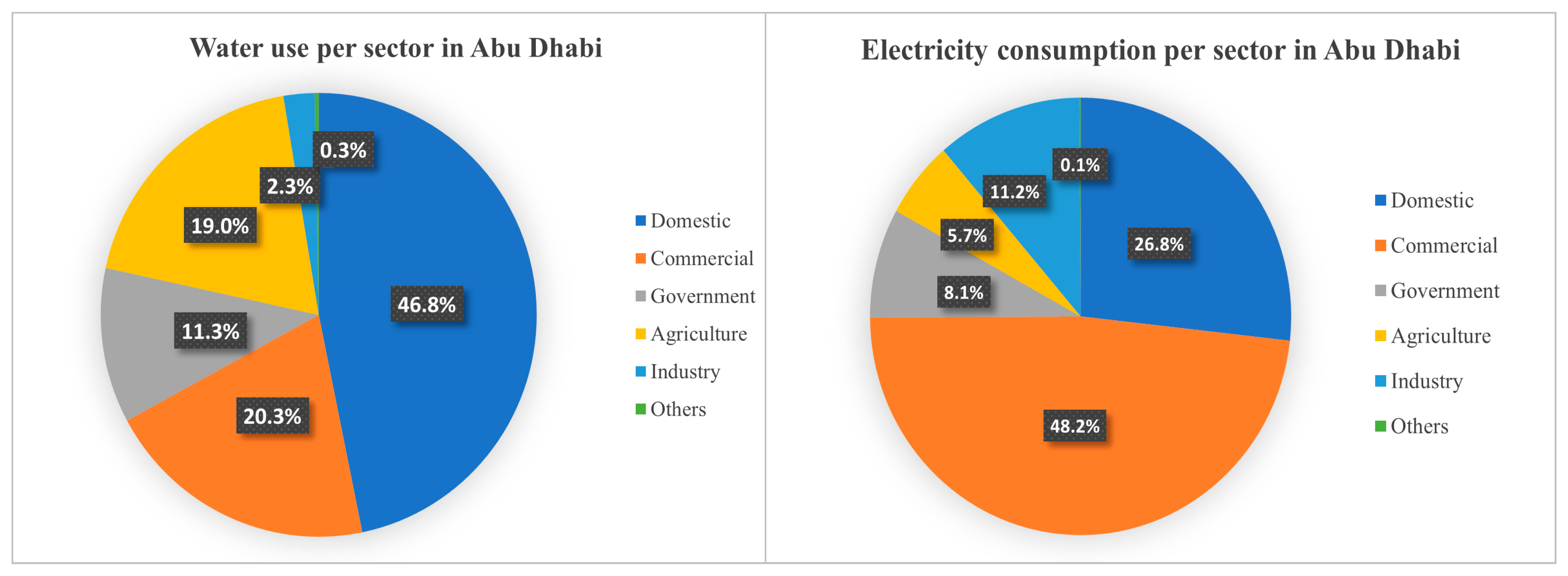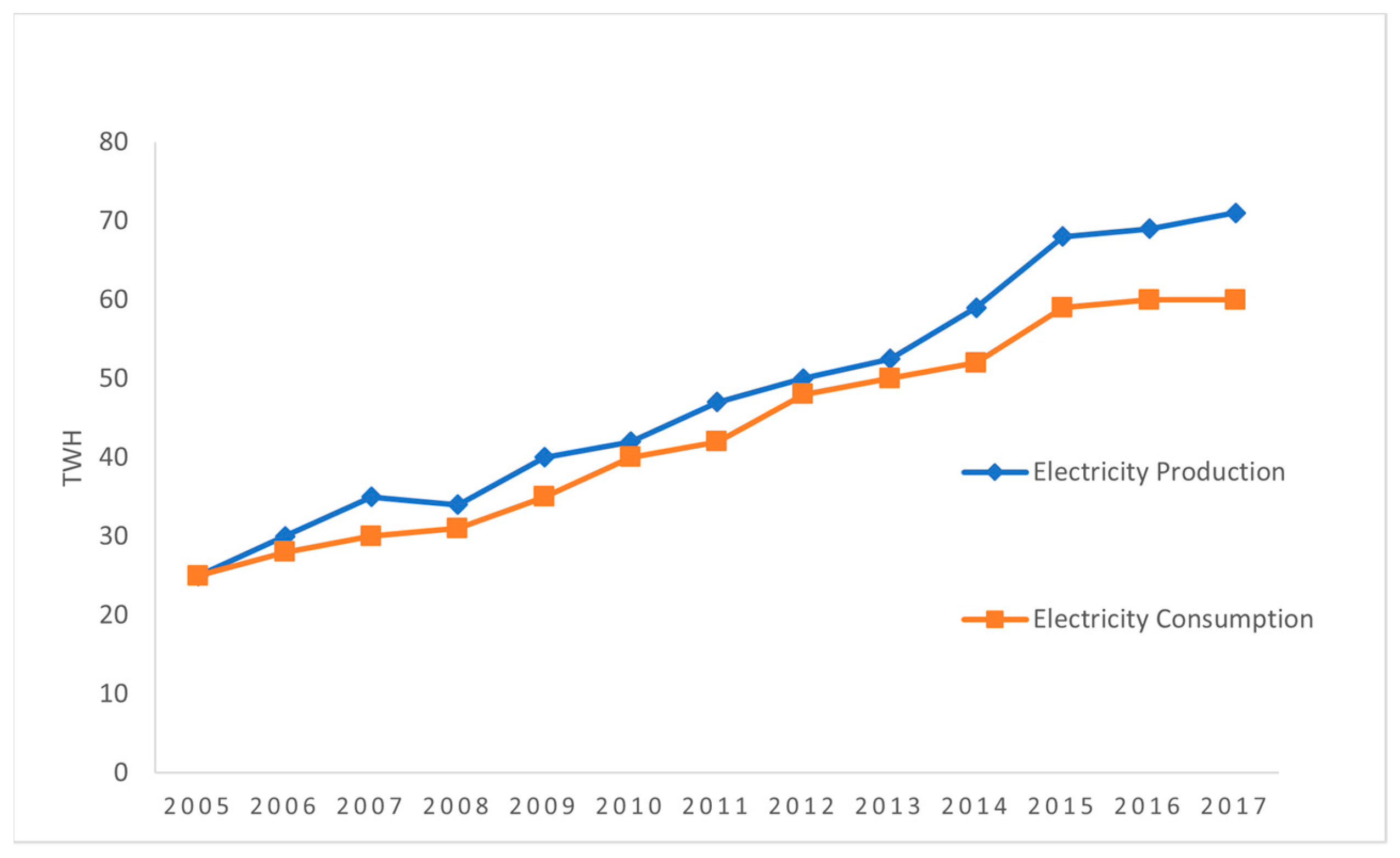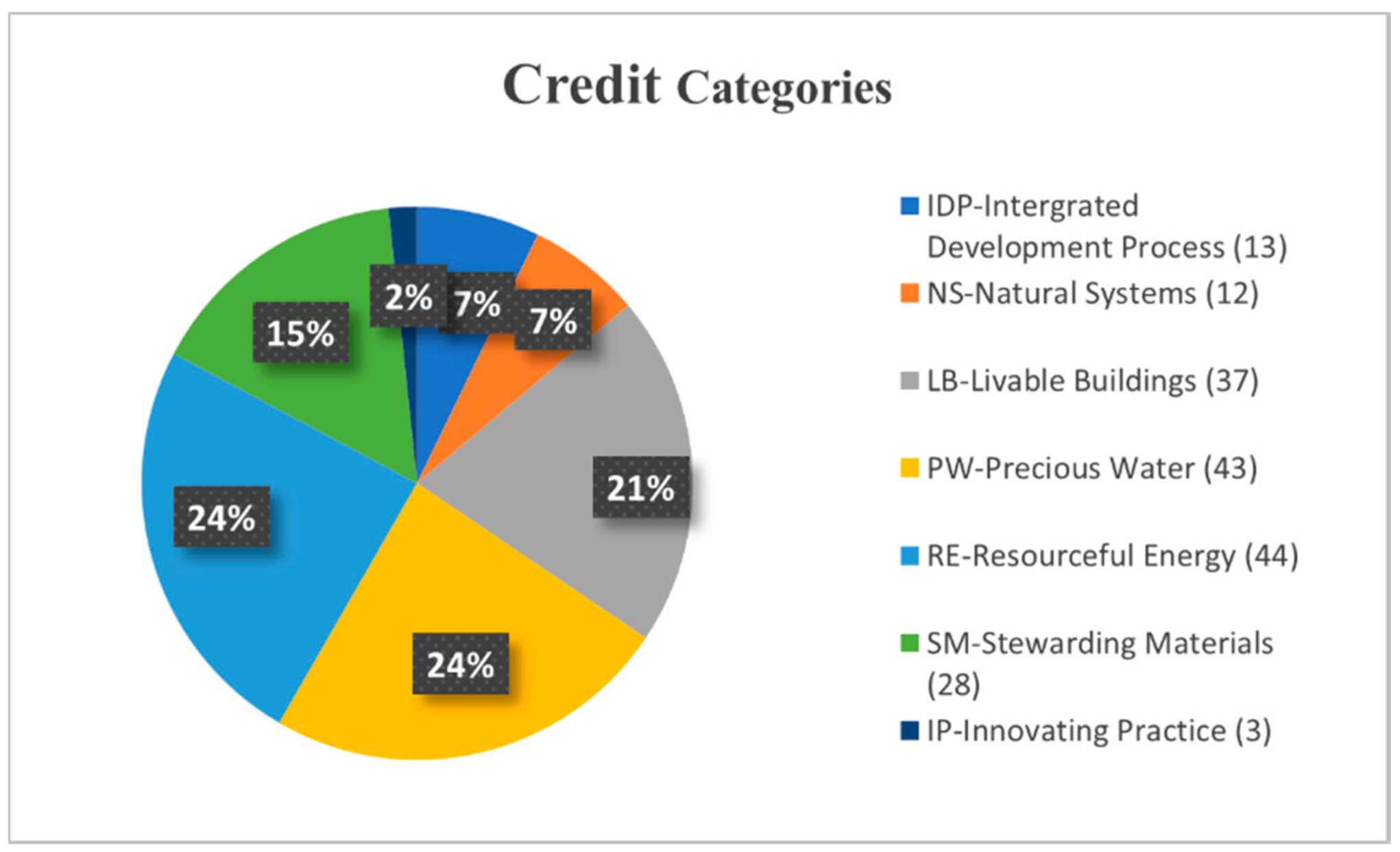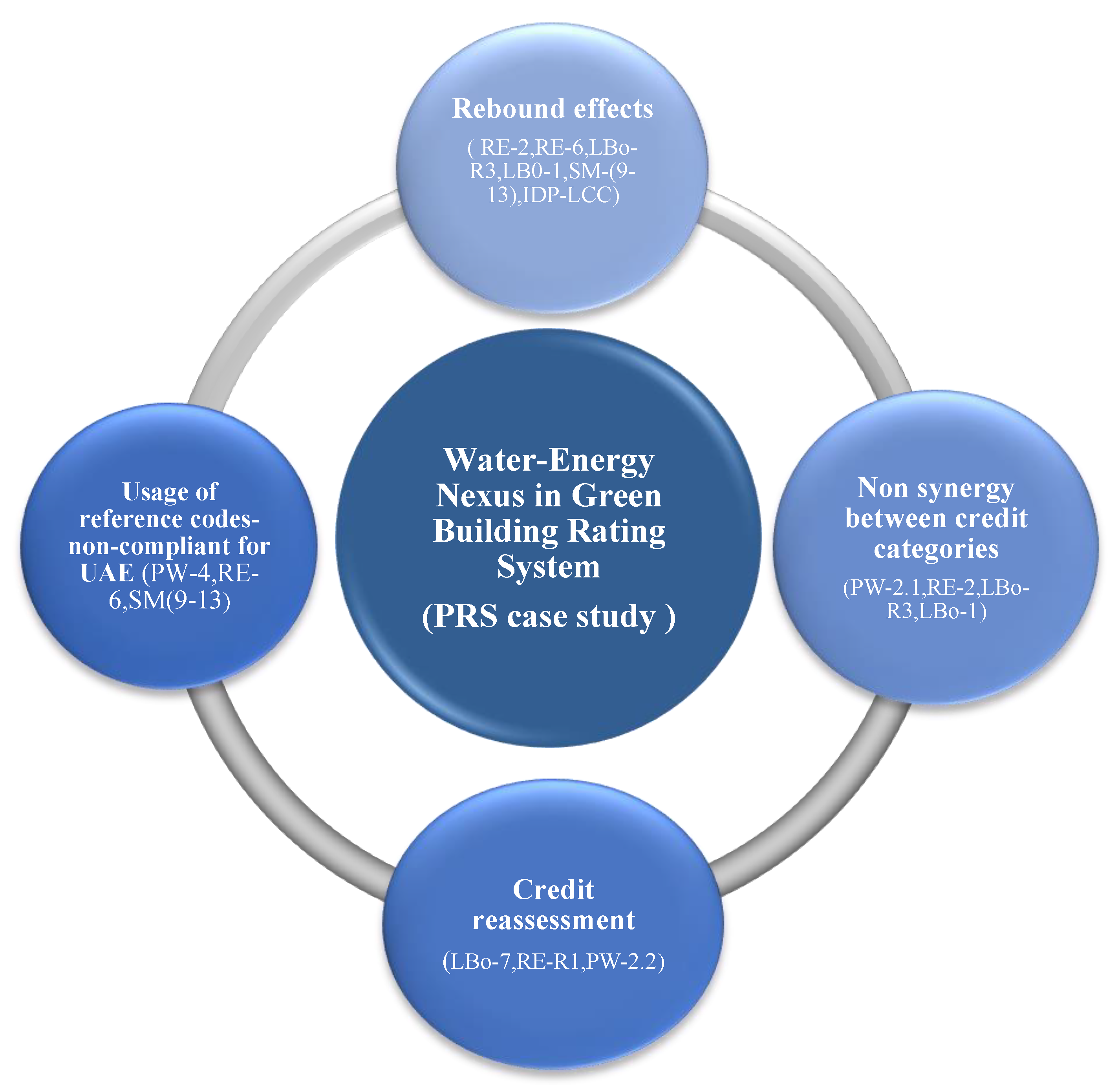Diagnoses for Potential Enaction of Water–Energy Nexus in Green Building Rating Systems: Case Study of the Pearl Rating System of United Arab Emirates
Abstract
1. Introduction
2. Review Methodology
3. Water–Energy Nexus: Conceptualization
4. Status of Water and Energy Consumption of UAE
5. Case Study: Pearl Rating System of Estidama
5.1. General Overview of Pearl Rating System
5.2. Case Study Description
5.3. Assessment of Energy Credits of Pearl Rating System
5.4. Assessment of Water Credits of Pearl Rating System
6. Results Comparison of Water and Energy Codes and Discussion about the Identified Pitfalls of Pearl Rating System
7. Recommendations to Implement Water–Energy Nexus in Pearl Rating System
7.1. Linking of Nexus in Energy Model Simulation
7.2. Rebound Effect of Renewable Energy Systems
7.3. Reassessment of Credit Points Distribution
8. Further Research Direction
9. Conclusions
Author Contributions
Funding
Conflicts of Interest
References
- Kazim, A. Strategy for a sustainable development in the UAE through hydrogen energy. Renew. Energy 2010, 35, 2257–2269. [Google Scholar] [CrossRef]
- Saxena, R.P.; Kumar, B.R. Greening for sustainability: Green UAE—A classic example. Interdiscip. Environ. Rev. 2020, 20, 118. [Google Scholar] [CrossRef]
- Al-Badi, A.; Almubarak, I. Growing energy demand in the GCC countries. Arab. J. Basic Appl. Sci. 2019, 26, 488–496. [Google Scholar] [CrossRef]
- United Arab Emirates—Countries & Regions—IEA. Available online: https://www.iea.org/countries/united-arab-emirates (accessed on 12 September 2020).
- Mohsen, M.S.; Akash, B.; Abu Abdo, A.M.; Akash, O. Energy Options for Water Desalination in UAE. Procedia Comput. Sci. 2016, 83, 894–901. [Google Scholar] [CrossRef]
- Paleologos, E.K.; Farouk, S.; Al Nahyan, M.T. Water resource management towards a sustainable water budget in the United Arab Emirates. IOP Conf. Ser. Earth Environ. Sci. 2018, 191, 012007. [Google Scholar] [CrossRef]
- Assaf, S.; Nour, M. Potential of energy and water efficiency improvement in Abu Dhabi’s building sector—Analysis of Estidama pearl rating system. Renew. Energy 2015, 82, 100–107. [Google Scholar] [CrossRef]
- Yoon, H. A Review on Water-Energy Nexus and Directions for Future Studies: From Supply to Demand End. Doc. d’Anàlisi Geogràfica 2018, 64, 365–395. [Google Scholar] [CrossRef]
- Kenway, S.K.; Lant, P.A.; Priestley, A.; Daniels, P. The connection between water and energy in cities: A review. Water Sci. Technol. 2011, 63, 1983–1990. [Google Scholar] [CrossRef]
- Scott, C.A.; Pierce, S.A.; Pasqualetti, M.J.; Jones, A.L.; Montz, B.E.; Hoover, J.H. Policy and institutional dimensions of the water–energy nexus. Energy Policy 2011, 39, 6622–6630. [Google Scholar] [CrossRef]
- Villamayor-Tomas, S. The Water–Energy Nexus in Europe and Spain: An Institutional Analysis from the Perspective of the Spanish Irrigation Sector. In Competition for Water Resources; Elsevier: Amsterdam, The Netherlands, 2017; pp. 105–122. [Google Scholar]
- Voinov, A.; Cardwell, H. The Energy-Water Nexus: Why Should We Care? J. Contemp. Water Res. Educ. 2009, 143, 17–29. [Google Scholar] [CrossRef]
- Gerbens-Leenes, W.; Hoekstra, A.Y.; Van Der Meer, T.H. The water footprint of bioenergy. Proc. Natl. Acad. Sci. USA 2009, 106, 10219–10223. [Google Scholar] [CrossRef] [PubMed]
- Griffiths-Sattenspiel, B.; Wilson, W. The Carbon Footprint of Water; River Network, Energy Foundation: Colorado, OR, USA, 2009. [Google Scholar]
- Dubey, K.; Krarti, M. Economic and Environmental Benefits of Improving UAE Building Stock Energy Efficiency; KAPSARC: Riyadh, Saudi Arabia, 2017. [Google Scholar]
- Lee, E. Indoor environmental quality (IEQ) of LEED-certified home: Importance-performance analysis (IPA). Build. Environ. 2019, 149, 571–581. [Google Scholar] [CrossRef]
- Wu, P.; Song, Y.; Shou, W.; Chi, H.; Chong, H.-Y.; Sutrisna, M. A comprehensive analysis of the credits obtained by LEED 2009 certified green buildings. Renew. Sustain. Energy Rev. 2017, 68, 370–379. [Google Scholar] [CrossRef]
- Suzer, O. Analyzing the compliance and correlation of LEED and BREEAM by conducting a criteria-based comparative analysis and evaluating dual-certified projects. Build. Environ. 2019, 147, 158–170. [Google Scholar] [CrossRef]
- Department of Urban Planning and Municipalities—Estidama Services. Available online: https://www.upc.gov.ae/en/upc-services-and-tools/services/estidama-services (accessed on 25 January 2020).
- Marsh, D.M.; Sharma, D. Energy-water nexus: An integrated modeling approach. Int. Energy J. 2007, 8, 235–242. [Google Scholar]
- Head, B.; Cammerman, N. The Water-Energy Nexus: A Challenge for Knowledge and Policy Urban Water Security Research Alliance Technical Report No. 39; University of Queensland: Queensland, Australia, 2010. [Google Scholar]
- Hardberger, A.; Stillwell, A.S.; King, C.W.; Webber, M.; Duncan, I.J. Energy-Water Nexus in Texas; The University of Texas: Austin, TX, USA, 2009. [Google Scholar]
- Kumar, M.D. Impact of electricity prices and volumetric water allocation on energy and groundwater demand management: Analysis from Western India. Energy Policy 2005, 33, 39–51. [Google Scholar] [CrossRef]
- Macknick, J.; Newmark, R.; Heath, G.; Hallett, K.C. A Review of Operational Water Consumption and Withdrawal Factors for Electricity Generating Technologies; NREL US Department of Energy: Colorado, CO, USA, 2011.
- Retamal, M.L.; Abeysuriya, K.; Turner, A.J.; White, S. Water Energy Nexus Literature Review; Institute for Sustainable Features, University of Sydney: Sydney, Australia, 2009. [Google Scholar]
- Bartos, M.; Chester, M.V. The Conservation Nexus: Valuing Interdependent Water and Energy Savings in Arizona. Environ. Sci. Technol. 2014, 48, 2139–2149. [Google Scholar] [CrossRef]
- DeNooyer, T.A.; Peschel, J.M.; Zhang, Z.; Stillwell, A.S. Integrating water resources and power generation: The energy–water nexus in Illinois. Appl. Energy 2016, 162, 363–371. [Google Scholar] [CrossRef]
- Huang, W.; Ma, D.; Chen, W. Connecting water and energy: Assessing the impacts of carbon and water constraints on China’s power sector. Appl. Energy 2017, 185, 1497–1505. [Google Scholar] [CrossRef]
- Scanlon, B.R.; Duncan, I.; Reedy, R.C. Drought and the water–energy nexus in Texas. Environ. Res. Lett. 2013, 8, 045033. [Google Scholar] [CrossRef]
- Conway, D.; Van Garderen, E.A.; Deryng, D.; Dorling, S.; Krueger, T.; Landman, W.A.; Lankford, B.; Lebek, K.; Osborn, T.; Ringler, C.; et al. Climate and southern Africa’s water–energy–food nexus. Nat. Clim. Chang. 2015, 5, 837–846. [Google Scholar] [CrossRef]
- Schuck, E.; Green, G.P. Supply-based water pricing in a conjunctive use system: Implications for resource and energy use. Resour. Energy Econ. 2002, 24, 175–192. [Google Scholar] [CrossRef]
- Mielke, E.; Anadon, L.D.; Narayanamurti, V. Water Consumption of Energy Resource Extraction, Processing, and Conversion—Energy Technology Innovation Policy Discussion Paper Series; Energy Technology Innovation Policy Project, Belfer Center: Cambridge, MA, USA, 2010. [Google Scholar]
- Glassman, D.; Wucker, M.; Isaacman, T.; Champilou, C. The Water-Energy Nexus: Adding Water to the Energy Agenda; World Policy Institute: New York, NY, USA, 2011; p. 35. [Google Scholar]
- U.S. Department of Energy. Estimating Freshwater Needs to Meet Future Thermoelectric Generation Requirements; National Energy Technology Laboratory: Albany, OR, USA, 2011; p. 83.
- Frankel, M.; Carbonnier, K. Quantifying the Water-Energy Nexus at the Building Project Scale; New Buildings Institute: Portland, OR, USA, 2017. [Google Scholar]
- Assaf, S.; Nour, M. Overview of Water Energy Nexus of Abu Dhabi’s Power Sector-Energy Water Analysis of End Use Segment. In ICREGA’14-Renewable Energy: Generation and Applications; Springer: Cham, Switzerland, 2014; pp. 315–328. [Google Scholar]
- Avtar, R.; Tripathi, S.; Aggarwal, A.K.; Kumar, P. Population–Urbanization–Energy Nexus: A Review. Resources 2019, 8, 136. [Google Scholar] [CrossRef]
- Energy and Water Statistics. Report of Abu Dhabi; Energy and Water Statistics: Abu Dhabi, UAE, 2017; pp. 1–19.
- Al-Mulali, U.; Sab, C.N.B.C. Energy consumption, CO2 emissions, and development in the UAE. Energy Sources Part B Econ. Plan. Policy 2018, 13, 1–6. [Google Scholar] [CrossRef]
- Kazim, A. Assessments of primary energy consumption and its environmental consequences in the United Arab Emirates. Renew. Sustain. Energy Rev. 2007, 11, 426–446. [Google Scholar] [CrossRef]
- Mezher, T.; Fath, H.; Abbas, Z.; Khaled, A. Techno-economic assessment and environmental impacts of desalination technologies. Desalination 2011, 266, 263–273. [Google Scholar] [CrossRef]
- Sgouridisc, S.; Griffiths, S.W.; Kennedy, S.; Khalid, A.; Zurita, N. A sustainable energy transition strategy for the United Arab Emirates: Evaluation of options using an Integrated Energy Model. Energy Strat. Rev. 2013, 2, 8–18. [Google Scholar] [CrossRef]
- Lattemann, S.; Höpner, T. Environmental impact and impact assessment of seawater desalination. Desalination 2008, 220, 1–15. [Google Scholar] [CrossRef]
- Siddiqi, A.; Anadon, L.D. The water–energy nexus in Middle East and North Africa. Energy Policy 2011, 39, 4529–4540. [Google Scholar] [CrossRef]
- Danks, R.; Good, J.; Sinclair, R. Assessing reflected sunlight from building facades: A literature review and proposed criteria. Build. Environ. 2016, 103, 193–202. [Google Scholar] [CrossRef]
- Priyadarsini, R.; Hien, W.N.; David, C.K.W. Microclimatic modeling of the urban thermal environment of Singapore to mitigate urban heat island. Sol. Energy 2008, 82, 727–745. [Google Scholar] [CrossRef]
- Sayed, M.A.A.E.D.A.; Fikry, M.A. Impact of glass facades on internal environment of buildings in hot arid zone. Alex. Eng. J. 2019, 58, 1063–1075. [Google Scholar] [CrossRef]
- Dewa Earns Region’s First Renewable Certificate Recognition, Gulf News. 2017. Available online: https://gulfnews.com/going-out/society/dewa-earns-regions-first-renewable-certificate-recognition-1.2065530 (accessed on 12 July 2019).
- Zhu, K.; Fang, L.; Diao, N.; Fang, Z. Potential underground environmental risk caused by GSHP systems. Procedia Eng. 2017, 205, 1477–1483. [Google Scholar] [CrossRef]
- Waste-to-Energy—The Official Portal of the UAE Government. Available online: https://u.ae/en/information-and-services/environment-and-energy/water-and-energy/types-of-energy-sources/waste-to-energy- (accessed on 12 September 2020).
- Bozorgirad, M.A.; Zhang, H.; Haapala, K.R.; Murthy, G.S. Environmental impact and cost assessment of incineration and ethanol production as municipal solid waste management strategies. Int. J. Life Cycle Assess. 2013, 18, 1502–1512. [Google Scholar] [CrossRef]
- Rahman, H.A. Incinerator In Malaysia: Really Needs? Int. J. Chem. Environ. Biol. Sci. 2013, 1, 678–681. [Google Scholar]
- Kuo, J.-H.; Lin, C.-L.; Chen, J.-C.; Tseng, H.-H.; Wey, M.-Y. Emission of carbon dioxide in municipal solid waste incineration in Taiwan: A comparison with thermal power plants. Int. J. Greenh. Gas Control. 2011, 5, 889–898. [Google Scholar] [CrossRef]
- Castri’, A.; Conti, R.; Fino, D.; Conti, E.; Di Bartolo, G. The Use of Water in the Incineration Plant of Torino; Environmental Science, IWWG: Venice, Italy, 2007. [Google Scholar]
- Lucchi, E.; Tabak, M.; Troi, A. The “Cost Optimality” Approach for the Internal Insulation of Historic Buildings. Energy Procedia 2017, 133, 412–423. [Google Scholar] [CrossRef]
- Wang, J.; Pan, W. Influencing parameters of the life cycle cost-energy relationship of buildings. J. Green Build. 2018, 13, 103–121. [Google Scholar] [CrossRef]
- Waste Management—The Official Portal of the UAE Government. Available online: https://u.ae/en/information-and-services/environment-and-energy/waste-management (accessed on 25 September 2020).
- Mawed, M. Construction and demolition waste management in the uae: Application and obstacles. Int. J. GEOMATE 2020, 18. [Google Scholar] [CrossRef]
- Becherini, F.; Lucchi, E.; Gandini, A.; Barrasa, M.C.; Troi, A.; Roberti, F.; Sachini, M.; Di Tuccio, M.C.; Garmendia, L.; Pockelè, L.; et al. Characterization and thermal performance evaluation of infrared reflective coatings compatible with historic buildings. Build. Environ. 2018, 134, 35–46. [Google Scholar] [CrossRef]
- Macintyre, H.L.; Heaviside, C. Potential benefits of cool roofs in reducing heat-related mortality during heatwaves in a European city. Environ. Int. 2019, 127, 430–441. [Google Scholar] [CrossRef] [PubMed]
- GCC|Renewable Energy Certificates. Available online: https://gcc.re/ (accessed on 25 September 2020).
- Atwany, H.; Hamdan, M.O.; Abu-Nabah, B.A.; Alami, A.H.; Attom, M. Experimental evaluation of ground heat exchanger in UAE. Renew. Energy 2020, 159, 538–546. [Google Scholar] [CrossRef]
- Berawi, M.A.; Miraj, P.; Sayuti, M.S.; Berawi, A.R.B. Improving building performance using smart building concept: Benefit cost ratio comparison. AIP Conf. Proc. 2017, 1903. [Google Scholar] [CrossRef]
- Li, Q.; Shu, Z.; Chen, F. Performance assessment of tall building-integrated wind turbines for power generation. Appl. Energy 2016, 165, 777–788. [Google Scholar] [CrossRef]
- Paltsev, S.; Reilly, J.; Jacoby, H.; Tay, K.H. How (and why) do climate policy costs differ among countries. In Human-Induced Climate Change: An Interdisciplinary Assessment; Cambridge University Press: Cambridge, UK, 2007; pp. 282–293. [Google Scholar]
- Hawit, O.; Jaffe, T. Water–Energy Nexus: Heat Rejection Systems. ASHRAE J. 2017, 59, 28–39. [Google Scholar]
- Al-Mulali, U.; Solarin, S.A.; Sheau-Ting, L.; Ozturk, I. Does moving towards renewable energy cause water and land inefficiency? An empirical investigation. Energy Policy 2016, 93, 303–314. [Google Scholar] [CrossRef]
- Johnson, E.P. Measuring the Productive Inefficiency in Renewable Electricity Generation; IRENA: Abu Dhabi, UAE, 2014; pp. 1–30. [Google Scholar]




| Credit Code | Credit Title | General Building Credits |
|---|---|---|
| RE-R1 | Minimum Energy Performance | Mandatory Requirement |
| RE-R2 | Energy Monitoring and Reporting | Mandatory Requirement |
| RE-R3 | Ozone Impacts of Refrigerants and Fire suppression systems | Mandatory Requirement |
| RE-1 | Improved Energy Performance | 15 |
| RE-2 | Cool Building Strategies | 6 |
| RE-3 | Energy Efficient Appliances | 3 |
| RE-4 | Vertical Transportation | 3 |
| RE-5 | Peak Load Reduction | 4 |
| RE-6 | Renewable Energy | 9 |
| RE-7 | Global Warming Impacts of Refrigerants and Fire suppression systems | 4 |
| Category Code | ‘Resource Energy’ Category | PRS Requirements | Identified Pitfalls | Technical Possibilities |
|---|---|---|---|---|
| RE-R1 | Minimum energy performance | ●The PRS focusses on performance improvements related to reduction in energy consumption ignoring energy costs. ●Use of code ASHRAE 90.2 for energy calculations. | May provide incomprehensive methodological analysis in relation to efficiency calculations in the PRS. | Modifications to reference codes reflecting the actual energy issues of the country. |
| RE-2, LBo-R3, LBo-1 | Cool building strategies, outdoor thermal comfort strategy, and improved outdoor thermal comfort | ●Recommends the use of high SRI roofing materials to reduce heat gain to the building, and the PRS argues this strategy will provide positive impact of local microclimate. ●Recommended to use vegetated roof gardens for cooling roofs. | ●Reflection of one building will affect the daylighting views and the energy requirements of adjacent buildings [47]. ●Increases urban heat island effect [46]. | ●IR reflective coatings for facades and roofs for hot climatic regions [59]. ●Reflective cool roofs and facades that generally have a lower temperature than ordinary or even vegetated roofs [60]. |
| RE-6 | Renewable energy | ●To provide renewable energy to grid and the bearer to be sufficed with renewable energy certificates (RECs). ●Credit awards for deep geothermal systems and landfill gas systems claiming these systems to be eco-friendly. ●Production of energy from waste diversion plants. | ●RECs have been provided in the UAE through I-REC since 2016 [61], even though the PRS was created in 2009. ●These systems have negative impacts like earthquakes and risks including release of toxic gases in case of waste incineration plants [49]. ●Most of the above systems are not currently established in the UAE [62]. Hence, it would be best if these credits are modified to only include what is currently possible in the country. | ●BIPV (Building-Integrated Photovoltaics) [63] as it suits the UAE’s climate. ●BIWT (Building-Integrated Wind Turbine), especially for tall buildings [64]. |
| IDP-LCC | Life cycle cost | ●Usage of non-local codes for LCC calculation methodology such as British standards without providing specifications suiting the UAE’s need. | ●LCC not linked to energy costs/efficiency as the UAE has strong concerns about electricity consumption [65]. | ●LCC-E savings would prove benefits [56], especially based on the UAE’s climatic, energy, and water conditions. ●Modifications in the reference codes to suit local needs will produce better solutions. |
| SM-9 to13 | Stewarding materials | SM category emphasize huge importance on incineration plants. | No incineration plants yet established in the UAE [57]. | Requires reassessment for this credit as it is important to include in the rating system, which can provide an actual credit score. |
| LBo-7 | Bicycle facilities | ●Provision of a max of 10 showerheads with safety lockers and changing rooms. | Due to intense and harsh weather conditions, people use bicycles only for 3–4 months/year, making these extra facilities redundant. | Need the credit to be reassessed in concordance with the UAE’s climatic conditions. |
| Credit Code | Credit Title | General Building Credits |
|---|---|---|
| PW-R1 | Minimum Interior Water Use Reduction | Mandatory Requirement |
| PW-R2 | Exterior Water Monitoring | Mandatory Requirement |
| PW-1 | Improved Interior Water Use Reduction | 15 |
| PW-2.1 | Exterior Water Use Reduction: Landscaping | 8 |
| PW-2.2 | Exterior Water Use Reduction: Heat Rejection | 8 |
| PW-2.3 | Exterior Water Use Reduction: Water Features | 4 |
| PW-3 | Water Monitoring and Leak Detection | 4 |
| PW-4 | Stormwater Management | 4 |
| Category Code | ‘Precious Water’ Category | PRS Requirements | Identified Problems | Technical Possibilities |
|---|---|---|---|---|
| PW-2.1 | Exterior water use reduction | Credit points like PW-2.1, NS-3, and NS-4 all encourage the use of native plant species. | Not considered synergy amongst the credit categories that may cause the client not to consider them altogether. | Need to consider all credit points encompassing the usage of native plant species to be grouped together; hence, the water requirement will be lesser and help in the credit accumulation savings for client. |
| PW-2.2 | Exterior water use reduction | 8 credit points are for non-water-based heat rejection system, and only 2–5 are awarded for water-based ones. | Research shows water-based ones are more efficient, and, hence, larger buildings can only use them instead of the air-based one [66]. | Need for the reassessment of distribution of credits points based on performance. |
| PW-4 | Stormwater management | Install appropriate systems and treat 90% of stormwater. Reference guide is Commonwealth Scientific and Industrial Research Organisation (CSIRO). | The UAE has little precipitation and hence does not justify the expensive installation of equipment that require additional energy for operation and maintenance. | ●The guideline mentioned not suited for the UAE’s hot desert climate; hence, it is recommended to be changed. ●Since precipitation is negligible, credit points could be reduced. |
© 2020 by the authors. Licensee MDPI, Basel, Switzerland. This article is an open access article distributed under the terms and conditions of the Creative Commons Attribution (CC BY) license (http://creativecommons.org/licenses/by/4.0/).
Share and Cite
Raveendran, R.; Hassan, A.; Tabet Aoul, K.A. Diagnoses for Potential Enaction of Water–Energy Nexus in Green Building Rating Systems: Case Study of the Pearl Rating System of United Arab Emirates. Energies 2020, 13, 5284. https://doi.org/10.3390/en13205284
Raveendran R, Hassan A, Tabet Aoul KA. Diagnoses for Potential Enaction of Water–Energy Nexus in Green Building Rating Systems: Case Study of the Pearl Rating System of United Arab Emirates. Energies. 2020; 13(20):5284. https://doi.org/10.3390/en13205284
Chicago/Turabian StyleRaveendran, Reshna, Ahmed Hassan, and Kheira Anissa Tabet Aoul. 2020. "Diagnoses for Potential Enaction of Water–Energy Nexus in Green Building Rating Systems: Case Study of the Pearl Rating System of United Arab Emirates" Energies 13, no. 20: 5284. https://doi.org/10.3390/en13205284
APA StyleRaveendran, R., Hassan, A., & Tabet Aoul, K. A. (2020). Diagnoses for Potential Enaction of Water–Energy Nexus in Green Building Rating Systems: Case Study of the Pearl Rating System of United Arab Emirates. Energies, 13(20), 5284. https://doi.org/10.3390/en13205284






